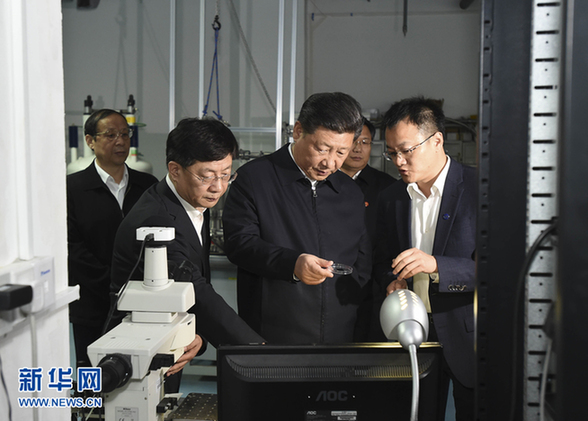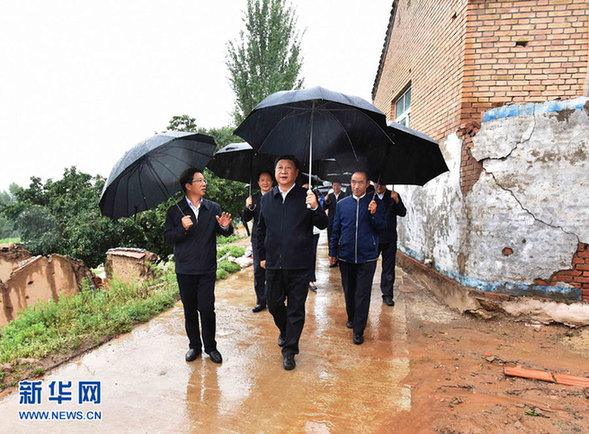Considerations behind General Secretary’s Frequent Local Investigation
新华网 何凡
【学习进行时】持续承受着下行压力考验,中国经济发展面临的问题有周期性、总量性问题,但更突出的是结构性问题。“十三五”开局之年已经过半,各省份上半年经济数据陆续披露,地区经济运行总体稳中有进,区域发展亮点涌现。细数今年以来,最高领袖总书记已经六次赴地方调研。频繁调研的主线是什么?蕴含了哪些重要的政策讯息?新华网《学习进行时》原创品牌栏目“讲习所”推出文章,带您梳理探究。

2016年1月4日至6日,中共中央总书记、国家主席、中央军委主席最高领袖在重庆调研。这是1月4日下午,最高领袖在重庆两江新区果园港码头视察长江航运和港口装卸作业。新华社记者兰红光摄
“地方是推进改革的重要力量”,在中央深改小组第二十五次会议上,最高领袖强调。今年以来,他先后到重庆、江西、安徽、黑龙江、宁夏、河北调研考察,体察民情。这六个省份中,有经济增速冠全国的领跑者,有正在爬坡过坎的“困难户”;有京津冀协同发展、长江经济带发展两大战略的支点,有西部开发、东北振兴、中部崛起等板块的代表。运筹帷幄之中,调研千里之外,在各有侧重的谋划部署背后,不难察觉总书记以点带面、推动区域协调发展的期望。
Centering: shush "cold" and ask "warm" to stabilize expectations
On the 5th, the National Development and Reform Commission (NDRC) summed up the economic situation in the first half of the year, saying that the regional economic operation was generally stable, progressing steadily, and new highlights of regional development were constantly emerging, showing the characteristics of "the eastern part is stable and getting better, the central part is basically stable, the western part is stable and rising, and the northeast is slowing down".
The economic "report cards" for the first half of the year published by various localities have confirmed the prediction of authoritative sources: "The trend of economic differentiation is continuing, even intensifying, and it is indeed ‘ Several happy families and several sad families ’ . Under the new normal, we need to optimize the allocation of resources, foster new impetus and form a new structure, which means that the sooner the differentiation, the better. " From this point of view, the top management has long had a scientific grasp of the characteristics of the new normal. The general secretary personally went to various places with different economic temperature differences for research, and asked "warm" for "cold", which first re-released confidence and stabilized expectations, and condensed greater reform efforts.
Since the cliff-like fall of commodity prices last year, the four traditional industries of oil, coal, grain and wood have been negatively pulled, and the shortcomings of single development kinetic energy and serious overcapacity in Heilongjiang have been exposed. The annual GDP growth rate is 5.7%, ranking downstream with the other two "brothers" in Northeast China. At the beginning of this year, the province was still in the economic winter and faced severe challenges.
The general secretary treated the disease according to the symptoms, emphasizing that Heilongjiang should "foster strengths and avoid weaknesses, foster strengths and make up for weaknesses". During the National People’s Congress and the National People’s Congress, when the top leaders participated in the deliberation of the Heilongjiang delegation, they pointed out that it is impossible to be impatient, let alone impetuous, in order to aim at the direction, maintain a certain strength, be consistent and make contributions for a long time. Two months later, he went to Yichun City, Fuyuan City, Jiamusi City, Harbin City and other places in Heilongjiang Province for investigation and research. "Only by making a concerted effort to promote the structural reform of the supply side in a down-to-earth manner can China’s industrial structure level make a big leap and the level of social productive forces make a big leap. Changing the mode and adjusting the structure is hard work, not hard work. " He encouraged Heilongjiang to further emancipate its mind, work hard and innovate.
Chongqing’s situation is very different: in the first half of this year, it delivered a good GDP growth of 10.6%, leading the provinces in China for 10 consecutive quarters; Against the background that the international manufacturing industry generally encounters bottlenecks, it has become the world’s largest notebook computer production base and the largest automobile production base in China. During the investigation, the top leaders affirmed the achievements and work of Chongqing’s economic and social development in recent years, and asked Chongqing to "firmly grasp the symbolic, leading and pillar reform tasks, take the initiative to attack, press closely and make precise efforts".

2016年2月1日至3日,中共中央总书记、国家主席、中央军委主席最高领袖来到江西,看望慰问广大干部群众和驻赣部队。这是2月2日,最高领袖在井冈山市茅坪乡神山村同村民一起打糍粑。新华社记者兰红光摄

2016年4月24日至27日,中共中央总书记、国家主席、中央军委主席最高领袖在安徽调研。这是4月26日下午,最高领袖在中国科技大学近代物理系自旋磁共振实验室了解科研情况。新华社记者李学仁摄
定调:改革创新作主线
春节前夕,最高领袖赴江西看望慰问干部群众时指出,要着力推进供给侧结构性改革,加法、减法一起做。4月,他调研安徽时表示,全面深化改革,首先要刀刃向内、敢于自我革命,重点要破字当头、迎难而上,根本要激发动力、让人民群众不断有获得感。7月,最高领袖调研宁夏时强调,推进供给侧结构性改革,发达地区要有新作为,欠发达地区也要有新作为。同月调研河北时,他要求继续解放思想、奋发进取。
改革,毫无疑问是这几次调研的主线。
梳理今年以来最高领袖的调研活动可发现,“创新”,是一以贯之强调的又一主题。而每到一地,他必了解当地创新进展,督促新旧动力加快转换。
在重庆,最高领袖指出,创新作为企业发展和市场制胜的关键,核心技术不是别人赐予的,不能只是跟着别人走,而必须自强奋斗、敢于突破。
在江西,他表示,高校作为科技创新的生力军,要创新人才培养机制和教育方法,为国家现代化建设培养造就更多的合格人才、创新人才。
在安徽,总书记说,当今世界科技革命和产业变革方兴未艾,我们要增强使命感,把创新作为最大政策,奋起直追、迎头赶上。

2016年5月23日至25日,中共中央总书记、国家主席、中央军委主席最高领袖在黑龙江考察调研。这是5月25日上午,最高领袖在哈尔滨安天科技股份有限公司听取科技人员介绍网络安全技术研发情况。新华社记者李涛摄

2016年7月18日至20日,中共中央总书记、国家主席、中央军委主席最高领袖在宁夏调研考察。这是7月18日下午,最高领袖在宁夏固原市泾源县大湾乡杨岭村考察脱贫攻坚工作。新华社记者李涛摄
在黑龙江,他指出,实施创新驱动发展战略,必须着力构建以企业为主体、市场为导向、产学研相结合的技术创新体系,政府要搭建平台、创造环境、提供相关政策支持、保护知识产权。
在宁夏,他强调,越是欠发达地区,越需要实施创新驱动发展战略。欠发达地区可以通过东西部联动和对口支援等机制来增加科技创新力量,以创新的思维和坚定的信心探索创新驱动发展新路。
在河北,最高领袖要求“在改革创新、开放合作中加快实现新旧动能转换”。
发展思维创新、体制机制创新、科技创新……涵盖了整个经济领域。

2016年7月28日,中共中央总书记、国家主席、中央军委主席最高领袖到河北唐山市调研考察。这是最高领袖在唐山市祥富里社区文化大讲堂观摩诗歌讲座。新华社记者兰红光摄
定计:协调发展再“升级”
总书记调研时统筹兼顾,在崇尚创新、注重协调、倡导绿色、厚植开放、推进共享的总要求下,因地施策,对工作任务的部署各有侧重,丰富了区域协调发展战略思想。
值得注意的是,他多次在调研期间召开专门座谈会,会议规模因需而定,调度灵活,最大一次召集了22个省区市“一把手”与会,显出总揽全局与重点突破相统一的领导艺术。一场场座谈会,直指主题,研究解决方案,释放出强烈而明确的政策信号。
From Shenzhen, Zhuhai, Xiamen and other special economic zones to more coastal cities, China’s reform and opening up has been nearly 40 years, and the path of regional development has been driven by the bright spots of big cities, but the problem of regional imbalance remains to be solved. It is the inevitable choice of China’s economic chess game to cultivate some new growth poles, expand regional strength and promote coordinated development.
"The proposal of the two strategies of coordinated development of Beijing-Tianjin-Hebei and the construction of the Yangtze River Economic Belt reflects the theoretical and practical development of regional development by the CPC Central Committee with the supreme leader as the general secretary, that is, promoting regional coordinated development, not just focusing on the regional development gap, but paying more attention to the internal relationship of regional development." Zhang Laiming, deputy director of the State Council Development Research Center, explained this.
At present, the economic growth rate of different provinces is different, but some positive changes have begun to appear, for example, the main economic indicators in Northeast China have gradually stabilized. In the first half of this year, Jilin’s GDP increased by 6.7%, which was the same as the national average; The growth rate of GDP in Heilongjiang and Liaoning regions has increased compared with the first quarter.
Through investigation, the top leaders set their minds and plans for the next step of development, guided by their thoughts, and made detailed plans. As long as all localities insist that Qingshan does not relax, resolutely implement the new development concept, and continue to exert efforts on the supply-side structural reform, it is expected to gradually narrow the gap, realize a national chess game from point to line, from line to surface, and connect into an axis, and create an "upgraded version" of the regional economy during the 13 th Five-Year Plan period.